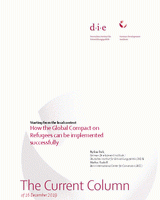Starting from the local context
How the Global Compact on Refugees can be implemented successfully
Dick, Eva / Markus RudolfThe Current Column (2019)
Bonn: German Development Institute / Deutsches Institut für Entwicklungspolitik (DIE), The Current Column of 16 December 2019
Bonn, 16 December 2019. Taking place in Geneva from 16 to 18 December 2019, discussions at the Global Refugee Forum are set to focus on the Global Compact on Refugees (GCR), which the United Nations General Assembly adopted in December 2018, and on its operational framework, the Comprehensive Refugee Response Framework (CRRF). The agreements envisage the following: firstly, reducing the pressure on communities hosting refugees; secondly, making refugees more self-reliant; thirdly, giving them better access to resettlement in (wealthier) countries outside their country of first arrival; and, fourthly, creating the conditions in their country of origin that would allow them to return voluntarily in safety and with dignity.
With the GCR, the international community has laid down an overdue paradigm shift in refugee policy at the highest level. Many crises and conflicts are cyclical, and many displacement situations persist for decades. These realities call for greater coordination between short-term emergency aid and long-term development cooperation. In African and Asian countries in particular, most refugees live in remote camps with no access to national labour markets, social services or opportunities to interact with their host society. This denies them prospects for the future and makes them dependent on aid from their host countries or international donors. The United Nations High Commissioner for Refugees (UNHCR) is thus committed to identifying alternatives to camp accommodation.
It is now widely accepted that the local level, i.e. sub-national government and administrative authorities as well as civil society groups, has a significant role to play in integrating refugees. However, local experience still attracts too little attention and importance in global policy-making. This is particularly true of communities in countries of the Global South, home to most of the world’s refugee movements. For instance, a World Bank study suggests that most of the over 4.6 million people who fled Venezuela between 2016 and 2018 are seeking refuge in its neighbouring countries, where they are concentrated in towns and cities, such as the Lima-El Callao metropolitan area in the case of Peru. According to the study’s authors, there is therefore an urgent need to convince the local population and decision-makers of the benefits of, in particular, integrating the (often well-qualified) refugees into the labour market.
But persuading people of advantages of integrating refugees in the spirit of sharing “global blueprints” is not enough. This is because the conditions for handling displacement on the ground vary considerably, as illustrated not least in research by the German Development Institute / Deutsches Institut für Entwicklungspolitik (DIE) and the Bonn International Center for Conversion (BICC) into local efforts to implement the GCR in Kenya. Apart from those living unofficially in the capital Nairobi and other Kenyan cities, most of the refugees (some 350,000 people) stay in one of the two major refugee camps: Kakuma in the north-west and Dadaab in the east, both arid regions. As a pilot country for implementing the CRRF, however, Kenya has committed to relaxing a camp policy that has so far been strict and driven by security concerns and to strengthen the refugees’ self-reliance and social integration.
A key element in this approach is the pilot settlement of Kalobeyei in the immediate vicinity of the Kakuma refugee camp, which is intended to help integrate the refugees with locals. In Kenya, with its restrictive migration policy, the project has been a successful exception. The settlement was planned based on an original initiative by the local government, which had spotted the potential that the refugees – some of whom had a better level of education as well as a knowledge of agriculture – offered for local development. The government also viewed the presence of international donors as a boon for the local economy, including beyond the boundaries of the Kalobeyei settlement itself. With development set to benefit everyone together, it also persuaded locals to make part of their land available.
Kalobeyei is a lesson in how implementing global refugee policy hinges significantly on the perceptions and interests of local actors, who should therefore be more closely involved in the discourse and processes of global policy-making. Development policy can support this by, for instance, (further) promoting the exchange of experiences between communities in the Global South and North. It can make some key contributions at local level, too: firstly, through area-based approaches that take context-specific opportunities and challenges as their starting point; secondly, with participatory settlement, land use and infrastructure planning jointly involving refugees and locals; and, thirdly, by supporting local authorities with their integration management and local service provision.
Eva Dick is a senior researcher with the programme “Transformation of Political (Dis-)order” at the German Development Institute / Deutsches Institut für Entwicklungspolitik (DIE).
Markus Rudolf is a senior researcher focusing on displacement, peace and conflict research and ethnic violence at Bonn International Center for Conversion (BICC).

